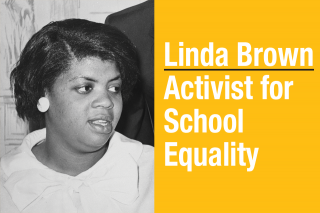Linda Brown of Brown v Board of Education Won, But More Must be Done
Recently the team at the UUA Office of Youth and Young Adult Ministries discussed how February being “Black History Month,” March being “Women’s History Month,” and June being “LGBTQ History Month” is positive because it raises up awareness of the history and contributions of these marginalized communities. But we also realized it relegates the history - and current imperfect condition of oppressed or marginalized groups in American society - to time-boxed public awareness. We think this is wrong because we have much to learn in the present moment by lifting up the stories of people who fight or suffer oppression all of the time. In this post we lift up Linda Brown, of Brown v Board of Education of Topeka: life-long activist for equal access to public education.
On this day in 1954 the United States Supreme Court delivered a landmark decision on school segregation, unanimously ruling in Brown v. Board of Education of Topeka that segregation in public education is illegal. The court decision famously states that, in the field of public education, the doctrine of "separate but equal" has no place. Separate educational facilities are inherently unequal.
Linda Brown was at the center of the fight. She realized the victory of Brown v Board of Education did not fully integrate the Topeka public schools. In 1979, with the assistance of the American Civil Liberties Union (ACLU), she sued again. Finally, in 1993, the U.S. Court of Appeals ruled in her favor, and the Topeka Public Schools was ordered to integrate. Linda Brown died on March 25, 2018 at 76 years of age.
However, the problem of unequal access in public school education persists.
As recently as 2016, the Federal court ordered schools in Cleveland, Mississippi to desegregate. Newsweek reports that School Segregation in America is as Bad Today as it was in the 1960's, reinforcing racial and economic inequities.
The PBS Newshour reported in BECOMING LESS SEPARATE? School Desegregation, Justice Department Enforcement, and the Pursuit of Unitary Status, by the U.S Commission on Civil Rights, that:
"...Inequities are caused by the fact that schools are most funded with state and local tax dollars. More than 92 percent of funding comes from nonfederal sources, according to the Education Department.
"The resulting imbalance renders 'the education available to millions of American public school students profoundly unequal,' the commission said.
"... the authors said 33 percent of high schools with high black and Latino enrollment offer calculus, compared with 56 percent of high schools with low black and Latino student populations. Nationwide, 48 percent of schools offer the rigorous math course."
Unequal access to education creates unequal outcomes for students later in life, and evidence that many public schools remain segregated includes unequal outcomes for people based on race. A Vox.com Explainer states, "Black Americans experience dramatically lower upward mobility than white Americans do — a difference that appears to be driven largely by significant economic disadvantages among black men."
Factors like mass incarceration by race and growing up in impoverished communities cause poor people of color to remain poor, and cause people of color who are not poor to fall into poverty at a higher rate than whites. Raj Chetty and Nathaniel Hendren write in the summary of their report, Race and Economic Opportunity in the United States:
"The challenge is that very few black children currently grow up in environments that foster upward mobility. Fewer than 5 percent of black children currently grow up in areas with a poverty rate below 10 percent and more than half of black fathers present. In contrast, 63 percent of white children grow up in areas with analogous conditions.” (Read the summary report here.)
The National Coalition on School Diversity has compiled a list of organizations fighting for public school equity .
